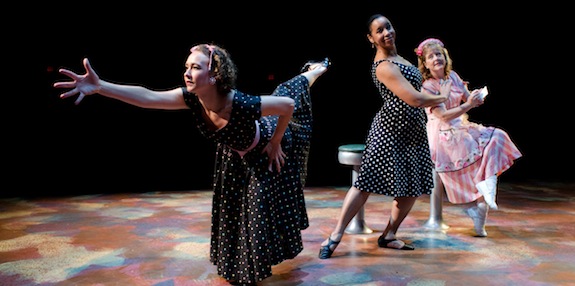A vengeful god, a woman’s inner turmoil and a neighborhood diner closed for the night — Orchesis Dance Company’s “DANCEVENT” transformed these images into stimulating works of modern dance.
Choreographed by faculty of the College of William and Mary’s department of theater, speech and dance, “DANCEVENT” featured student, faculty and alumni performers who showcased the collaborative dynamics of the modern dance style. With a refreshing variety of aesthetics, each of the nine individual pieces was well-executed and striking to watch. An even mix of ensembles, solos and duets that varied in emotion and intensity lent an overall sense of intentioned spontaneity. However, the lengthy transitions between each piece made the overall performance seem to drag longer than it should have.
Leah Glenn’s self-choreographed solo “Letting Go” opened the performance with polished precision and unwavering tension. Combined with a well-executed lighting design, crafted by David H. Dudley, the solo proved to be an ideal opening piece to elaborate the dynamics of modern stylization. In another key solo, “Outside In,” Lauren B. Morris expressed raw emotion with palpable insecurity and discomfort.
One of the evening’s longest pieces, “Perceived Threat,” choreographed by professor Glenn, played with elements of stillness and difference to create poignant suspense that, as the title suggests, challenged the way in which individuals perceive and interact with things that are unfamiliar and unknown. A longer piece called “Balancing in the Shadows,” choreographed by Denise Damon Wade, made bold use of stage lighting and accentuated key performers with intense precision spotlights.

As the director, choreographer and editor of the experimental short film “When God Is Silent,” Wade incorporated the medium of film into “DANCEVENT.” The film’s director of photography, Erin Harvey, captured the old-fashioned charm of the “DANCEVENT’s” schoolhouse set while instilling an unsettling sense of unease with odd angles and a lack of diegetic sound.
Choreographed and originally performed by Aura Curiatlas, “Dust” featured professor Joan Gavaler and Dan Plehal ’09, whose feats of acrobatic power and dexterity demonstrated strength of an almost primordial elegance. Their slow and heavy movements fit the tone of both the music and the choreography, but they were, understandably, shaky in some instances. “Gemini,” choreographed by Glenn, presented a different style duet with Julia Reidbord and Emma Stokton, whose endurance and distinct juxtapositions combined to form smooth body formations of lengthening and contraction.
The most fanciful piece of “DANCEVENT” was “Closing Time,” choreographed and performed by Glenn, Morris and Wade. Performed in a minimalistic diner in the 1970s, the scene was set without detracting from or impeding the dancers. In fact, it accentuated each dancer through the use of costume designs and character interactions. The choreography was also appropriately attuned to the suave sounds of Tony Bennett, unraveling the piece into a comforting narrative by allowing the songs’ lyrics to sway the story.
Perhaps the strongest piece in its conviction and performance was “Symbiosis,” choreographed by Morris, for its smooth and organic flow. Morris’ choreography deftly showcased the strengths of each of the piece’s eight performers.

